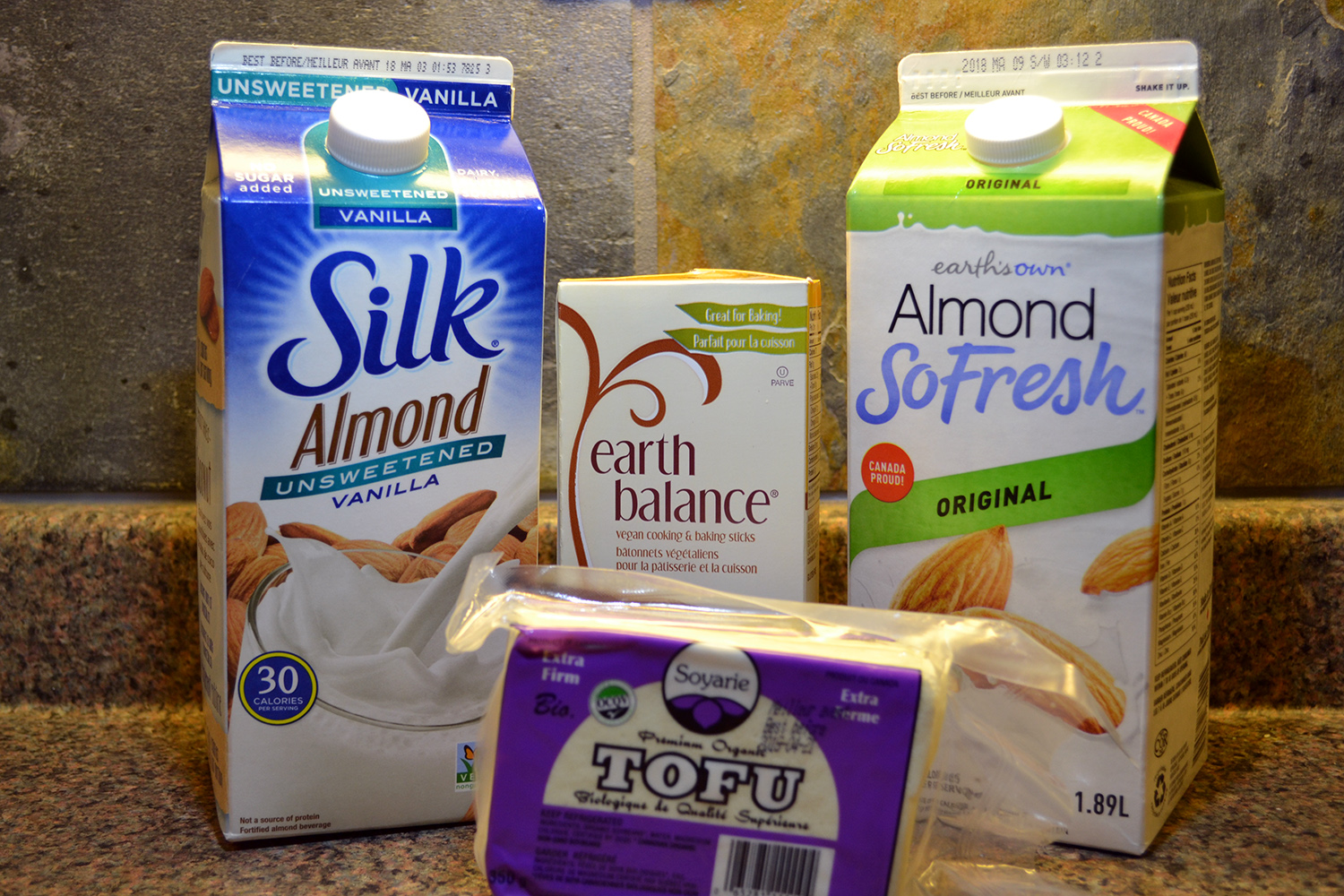Who needs dairy? Experts debate the de-milking of the Canada Food Guide

When Olivia Cruickshank and her husband opened up a vegan and vegetarian restaurant in Ottawa, they had no idea how popular it would become.
Pure Kitchen opened their second location on Elgin Street last year, and continues to draw people in with their healthy plant-based dishes.

Chef Olivia Cruickshank is the co-owner of Pure Kitchen. (Photo courtesy of Olivia Cruickshank)
“It’s really interesting, when we opened three years ago we did not think we were going to be this busy,” says Cruickshank.
Cruickshank says the success of Pure Kitchen is a reflection of changing attitudes towards vegetarianism and veganism. While vegetarians abstain from meat, vegans don’t eat any animal products – meat, dairy, eggs, or honey.
“There really has been a huge shift in the last several years, not just for veganism and vegetarianism, but for healthy eating in general,” Cruickshank says. “Even when you look past our restaurant, there are so many restaurants focusing more on vegetable centric cuisine.”
According to a poll conducted at Dalhousie University, two-point-three per cent of Canadians now consider themselves vegan.
But a diet without dairy defies the Canada Food Guide, which has long been a the government-approved formula for healthy eating in Canada, followed by registered dietitians and school nutritionists. The current Food Guide, last updated in 2007, categorizes dairy as its own food group and recommends daily consumption of anywhere from two to four servings a day, depending on age.
The official dairy recommendation dates back to 1942, when the first-ever Canada Food Guide was introduced as a way to prevent nutritional deficiencies during wartime rationing. Although Health Canada says that “little [was] recorded about the process used to develop the earliest food guides for Canada,” the guide was designed by medical and welfare workers. Since 1942, dairy has always been its own food group. The Canada Food Guide has been redesigned seven times since then. Veggies and fruit merged into one food group in 1977, and meat expanded to include “alternatives” in 1992. Dairy expanded to include “alternatives” in 2007, advising Canadians to “drink fortified soy beverages if you do not drink milk.”
The Food Guide may finally be catching up with vegan diet trends however, as Health Canada revealed that it is removing dairy as its own food group, and creating one “protein” group that emphasizes plant-based alternatives. Canada hasn’t confirmed exactly when the revamp will be released, however they have committed to putting out the general Canada Food Guide in winter 2018, and a supplement focusing on Indigenous nutrition in spring 2019.
Doug Goff, professor of dairy science at the University of Guelph, disagrees with the upcoming changes. He says dairy is simply the easiest option for most time-crunched Canadians.
“It’s very difficult to put together a diet that provides the [Recommended Dietary Allowance] for calcium in the absence of dairy,” says Goff.
Goff points to children’s food preferences as one big source of concern. While most kids are happy to snack on a grilled cheese or strawberry yogurt, far fewer would enjoy a large serving of calcium-rich broccoli, kale, spinach, or tofu.
“Many kids drink lots and lots of milk and eat yogurt tubes, and it provides a convenient, usually enjoyable way of packing a pretty big nutrient punch into your diet,” says Goff. “It’s a great source of nutrition, but it’s also a very enjoyable and easy food to consume.”

As for adults, Émelie Jadot, communications coordinator at the Dairy Farmers of Canada, says most Canadians don’t get enough calcium, magnesium, zinc, potassium, vitamin A, vitamin C, or fibre. “It is important to highlight that milk and dairy products are a valuable source of up to 6 of these 8 nutrients, which explains why their consumption is an easy way to address these deficiencies,” says Jadot.
Ottawa-based registered dietitian Deborah Sloan agrees that calcium is important, but says families can also get it through fortified plant sources.
“I don’t think that milk is 100 per cent necessary, but some sort of fortified dairy alternative is,” says Sloan.
Goff, however, questions whether the average Canadian has the time it takes to construct a healthy vegan diet.
“If you choose not to consume dairy at all, or even to consume low levels, then you need to think about the consequences of that in terms of overall diet,” says Goff. Whether or not people actually have the time to be mindful about food? “That’s the big question.”
Even aside from it’s well-known calcium content, Goff says dairy is a lot more nutritious than naysayers give it credit for, particularly when it comes to creating a complete protein.
Plant proteins like those from grains and vegetables are usually lacking in two important amino acids: lysine and methylamine. If the body doesn’t get all of the amino acids it needs, it can’t turn food protein into usable protein, which can lead to malnourishment.
“The reason why you add milk to cereal is to make sure you get that lysine content that you need, and so that the cereal’s protein is all absorbable,” says Goff.
Milk fat is another boon to dairy, says Goff. While some people may be wary of milk’s fat content — and therefore high caloric value — Goff says it’s actually a great source of nutrition.
“For too long, we’ve deemphasized fat,” says Goff. “Milk fat is very good in terms of risk reduction of cardiovascular disease, Type 2 Diabetes, obesity, and blood pressure.”
But the studies don’t all confirm Goff’s position. For example, 2016 study by Harvard public health researchers in the The American Journal of Clinical Nutrition found that while dairy didn’t worsen the risk of heart disease or stroke, it also didn’t lessen it. In fact, replacing dairy fat with vegetable fat or polyunsaturated fat – the kind present in nuts, seeds, and fish – reduced heart disease risk by 10 to 24 per cent. A similar 2015 review by Health Canada found that replacing saturated fats with unsaturated fats could help reduce the risk of cardiovascular disease and Type 2 diabetes; dairy products can be high in saturated fats.
Goff himself has been called the world’s leading expert in ice cream, and he grew up working in the ice cream factory his father managed. While Goff himself has turned down jobs in the dairy industry, he acknowledges that his institution, Guelph University, has strong ties – both historical and financial – to the Canadian dairy sector.
But for many Canadians, taste and nutrients might not be the most important factors. Even for people who want to avoid dairy, plant-based substitutes like nut cheeses and soy yogurts are simply too pricey to adopt as dairy substitutes.
“Coming from a parent who has had to go a soy-based route for my son, because he had an issue with casein as a baby, it is quite a bit more expensive,” says Sloan. For low-income Canadians faced with a food guide that emphasizes plant-based dairy alternatives, which often cost more or are only available at high-end supermarkets like Whole Foods, alienation from the Food Guide or feelings of food-shame are concerns. “There could really be an issue there,” adds Sloan.

However, Sloan says the Food Guide’s focus on dairy can often worry parents of lactose or casein intolerant kids. “The education isn’t there,” around plant-based alternatives, says Sloan. “If there is an intolerance, [your kids] can be perfectly healthy without it.”
Despite dairy’s benefits and cheaper price point, Sloan still thinks Health Canada’s decision to de-emphasize dairy is a good choice — and a far more inclusive one than keeping dairy as its own food group.
While some people choose not to eat dairy for environmental or ethical reasons, a large number of Canadians are lactose intolerant. According to the U.S. National Library of Medicine, around 65 per cent of people are lactose intolerant to some degree, with lactose malabsorption being particularly common in people with West African, Jewish, Greek, Italian, and Arab ancestry. Lactose intolerance affects up to 90 per cent of people of East Asian descent — an ethnic group that StatsCan says makes up roughly 11 per cent of Canadians. The current food guide’s focus on dairy isn’t just impractical for vegans; it could actually be racially insensitive.
“Looking at milk as its own category does somewhat alienate those people who are doing a plant-based diet,” says Sloan. “Ultimately I think this way will be less judgmental.”
As of 2018, the science doesn’t seem to sway either way. What we know for certain: humans need calcium, vitamin D, protein, and fat, and dairy is an easy way to get those things. But it’s far from the only way. If veganism continues to rise in popularity and fortified dairy substitutes such as soy milk become more affordable and more widely available, de-emphasizing dairy may become a more accessible choice for working class Canadians. And the decision to consume dairy is a highly personal one, fraught with not only health worries and individual lifestyle concerns, but emotional and ethical undertones.
Animal cruelty and environmental pollution in the agricultural business are also big issues, says Sloan. “How are the cows being treated? That’s why a lot of people are moving away from dairy.”
And then there’s the taste factor: cheese can be a hard thing to forgo.
For cheese lovers who think it’s impossible to give up dairy, Cruickshank says cheese substitutes have come a long way in terms of replicating the taste and texture.
“Faux cheese is really evolving right now, and it’s really exciting. In house here we make cashew cheese. It’s like a spread with a cashew base. Nuts are such a great substitute when making a faux cheese. It has the oil and the fats in it and nutritional yeast, which also contains B-12, which is excellent for vegans and vegetarians, and you get a really good flavour coming out of that” Cruickshank says.
Cruickshank says at Pure Kitchen, she loves to prove skeptics of veganism wrong.
“You know, they think they’re going to be hungry after or it’s not going to have flavour or all they’re going to eat is salad, and we’re definitely demonstrating that there’s a lot more to plant-based food than what maybe people’s ideas were,” Cruickshank says.
With the continued success of her restaurant, and Health Canada’s more plant-centric Food Guide on the horizon, Cruickshank is confident that views on nutrition and healthy eating are turning away from dairy.
“I think that as more restaurants open up and more food blogs support and promote plant-based foods, you’re going to see a lot more of plant forward and plant centric views out there,” says Cruickshank, “and meat and dairy just aren’t really the front runners anymore.”
Milk Myths & Quack Science
On the internet, dairy has a lot of detractors. While some bloggers do their research, not everyone is so rigorous. Dr. Doug Goff and Deborah Sloan R.D. bust the four myths that bug them the most.
Myth #1: Milk is Inflammatory
“Flat-out classifying dairy as inflammatory is a biggie,” says Sloan. “I’ve gone to the literature, and I haven’t seen any strong evidence for that. In fact, it points to being anti-inflammatory in certain cases.” Sloan says there is no published evidence for dairy causing inflammatory skin issues like eczema or acne.
Myth #2: Drinking Milk is Unnatural
“The one that really drives me nuts is when I see this statement that humans are the only species that drinks the milk of another species. That is just such nonsense,” says Goff. “We’re also the only species that cooks our food. You don’t see bears sitting in the woods around a campfire.” Goff says that since humans have been drinking milk for thousands of years, and many populations have evolved to keep their lactase enzyme as adults, dairy consumption is nothing if not natural in 2018.
Myth #3: Pasteurized Milk is Worse For You Than Raw Milk
“The idea that pasteurized milk is bad for you because of the processing is just… I almost don’t even want to comment on that because raw milk is so dangerous,” says Sloan. According to Sloan, the process of pasteurization doesn’t remove any nutrients from milk, and just consists of heating the milk up to kill bacteria. Raw milk, or milk that hasn’t been pasteurized, is often rife with potentially-deadly foodborne pathogens like E. Coli, Campylobacter, Salmonella, and Listeria. While raw milk is trendy amongst some, it’s actually illegal to sell in Canada.
Myth #4: Milk is Full of Growth Hormones and Antibiotics
Growth hormones and antibiotics are a real concern for American milk-drinkers, but Canadians can breathe a sigh of relief. Giving growth hormones or antibiotics to a dairy cow is illegal in Canada. According to the Dietitians of Canada website, if a dairy cow does have an infection that requires antibiotics, such as mastitis, they are removed from the milking herd until the antibiotics are out of their system, and the contaminated milk is thrown out

